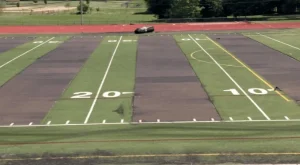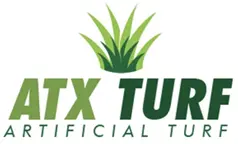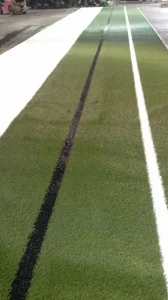Existing Lines in Turf: Where do they come from? And Ways to Deal With Them
Published February 21, 2023
Buying Turf with Lines is often a smart, economical option to get the benefits of turf, while saving a lot of money.
Chances are, your spouse does not want a yellow line running through the middle of the front yard, but for less conspicuous yard areas, batting cages and doggie day care facilities, turf with lines can be largely concealed or removed with the same end result as all green turf. Installing turf in oddly shaped yards and spaces requires cutting the turf anyways, and simply cutting the lines out is not that much more work in the end.
Understanding why the lines are where they are, and what you can do about it, will help make life easier, if you purchase artificial turf with lines in it.
Why are there lines in Turf?
Let’s start with asking why is there turf with lines in it available, anyway? In the athletic field manufacturing process, lines are tufted into the turf for the convenience of maintaining athletic fields. While some facilities still use paint to create the yard and boundary lines, having the lines tufted into the turf during the manufacturing process saves thousands of hours of field marking and it looks better than painted lines fading over time.
Imagine a sewing machine with hundreds of needles lined up 15’ across with hundreds of spools of green yarn fed into the needles. In order to make a 4 inch white line, 8 to 10 green spools of yarn are replaced with white(or any other color) spools of yarn. When the backing is run through the “sewing machine”, Voila!, you have a 4 inch white line in the green turf coming out the other side. Note: Hashmarks, numbers, circles and logos are all cut into the turf on the construction site.

Turf with Lines in Middle
Some turf manufacturers design fields with the football yard lines to be on the edge of the 15’ wide rolls, while other’s design the fields to have the white line in the middle. The sideline rolls, which run perpendicular, often have the 4 ft, white, coaches box, a yellow soccer field border and maybe another line for lacrosse or field hockey. In these cases, you may see rolls with multiple lines in varying colors.
How to Cut Lines Out of Turf
If you have purchased turf with lines, and you simply want them gone, you can cut them out. It’s fairly simple. With a box cutter with a fresh blade, you can lay the turf upside down, pick the stitch rows on either side of the colored line and slice it all the way down. See our article on How to Cut Artificial Turf. With a sharp box cutter and brand new blade, it takes about 30 minutes to cut out a single, 4 inch line out of a 100 ft long roll of turf. Not much time considering the cost savings of turf with lines in it.
If you need to seam it back together it can take longer. Depending on what you are using the turf for, you can seam the two pieces back together, or simply stake the two pieces of green to the ground next to each other. You can also use Turf Tape, available here.
If the line is on the very edge of the turf, it is even easier. There is just one cut to be made, as opposed to the two cuts you would have to make with a line in the middle of the roll. You can simply fold back the edge, and slice off the last 4 inches of colored stitch rows. When installing turf, you should slice off the factory selvedge edge, anyways, so there is actually no more work than you would have with all green turf.
Painting the Lines in Artificial Turf
While it is difficult to get inlaid turf lines to go away 100% with paint, many customers have had success in minimizing the lines 95%, so they are not as much a distraction.
It is recommended to use Artificial Turf Paint, available in aerosol cans (in 12 can cases) and 5 gallon buckets. One aerosol can covers 25, 4 inch wide, linear feet. Normal spray paint found at Home Depot will NOT adhere to the fibers very well, and will fade quickly, making the lines re-appear within days. The aerosol cans will work fine for a single line in 70’ or 100’ foot batting cages. For larger areas, or frequent painting, using a pneumatic paint sprayer (with a wide nozzle) is ideal, as seen in our video above.
The trick with painting turf, is that you will need to do several coats. Once the first coat dries, and the fibers get some wear, they will shuffle, exposing the fibers that did not receive the first coat of paint, and the line will “re-appear.” Then apply the second coat, and so forth, until the line slowly disappears.
Artificial Turf Green Paint Color Matching
Artificial Turf can come in many shades of green. You’ll see Lime Green, Emerald Green, Olive Green, Forest Green etc.. If you REALLY want to match the green PAINT color to the green TURF color, we recommend buying several different shades of green paint, and experimenting on a small section, using one shade for one coat, then another shade with another coat, and so forth, to see how closely it matches. Note: Wait till the paint dries to see what the final shade will look like, as it will change colors as it dries. On one project, we mixed a lime green and olive green, and it matched very closely to the existing green fibers of that particular turf.
As with any DIY project, having the right tools and instructions at the beginning will help your project go much smoother and save time with superior end results. If you buy turf with lines, having the right paint, the right color paint or if you choose to cut it, a box cutter with fresh blades, ahead of time will help your project go much smoother. The ATXTurf team has installed turf with lines for many applications across the US, so feel free to call your rep with questions. 866-428-2809.


If I purchase this lined turf will I know where the lines are prior to purchase ?
Line turf good for backyard putting green?
Hi Robert, Not really, the pile height is too tall for putting greens. Here’s a link to our putting green turfs.. https://atxturf.com/product-category/putting-green/